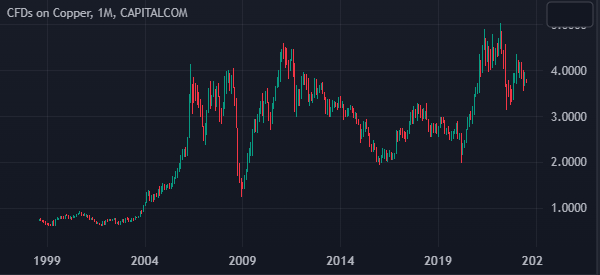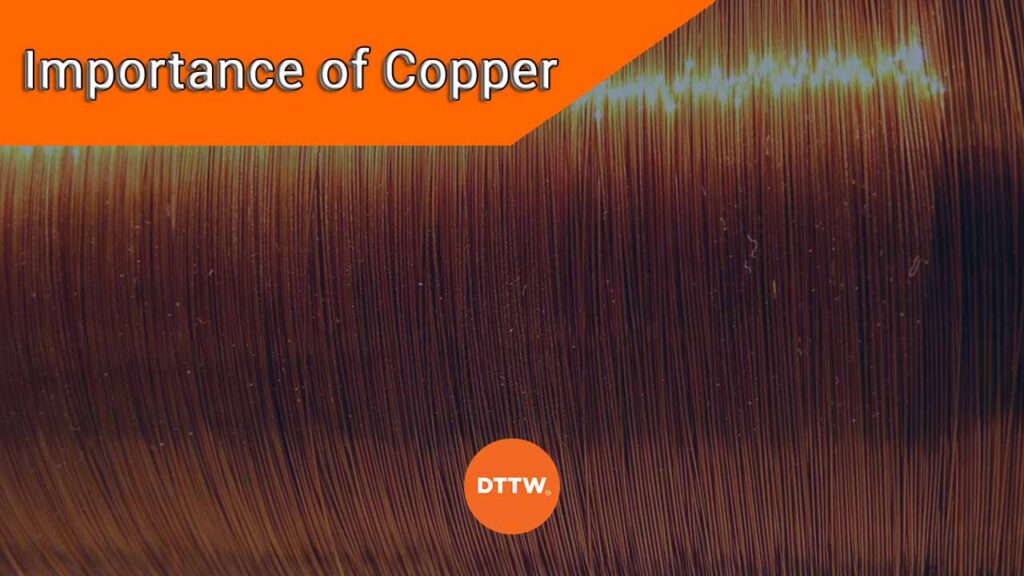Copper is one of the most important metals in the world. Every day, it is directly and indirectly used by billions of people around the world. For example, when you switch on your electricity, you have used it because it is the one that is used in transmission lines. Similarly, when you make a phone call, you indirectly use this metal because it is available inside the phones.
Therefore, because of this, copper is often viewed as a barometer of the world economic growth. If the economy does well, it means that the demand for it will be high, which will lead to higher prices.
The Economic Importance of Copper
Copper is one of the most important commodities in the financial market. That’s because it is used in some of the biggest sectors in the economy. For example, because of its high rate of conductivity, it is widely used in the electrical sector. It is used in the main electricity grids of most countries.
Also, in recent years, the ongoing shift from gasoline cars to electric vehicles has led to more demand for copper. That’s because a typical electric car like Tesla has more of it than a normal fuel car.
Therefore, financial participants usually view copper as an indicator of the health of the world economy. Furthermore, the price tends to rise when the global economy is expanding. It also tends to decline when there are shocks to the world economy.
Uses of copper
Copper is an important metal in the world. Its key characteristics of high melting point, conductivity, and corrosion resistance make it ideal for several uses. Some of its main uses are in:
- Use by utilities – Electricity companies use copper for their transmission lines.
- Use in construction – Copper is widely used in the construction industry, where it is mostly used in wiring.
- Automobile – Copper is used in the automobile sector. As the world moves to electric vehicles, the use of copper will continue rising.
- Manufacturing – Copper is widely used in the manufacturing sector. Some of the most popular areas are in the appliances, machining, and other products.
- Art and jewelry – Further, copper is used in the art and jewelry sector. For example, it has some uses in the watch-making sector and sculptures.
Other uses of copper are in the manufacture of fungicides water treatment, solar panels, and batteries.
What moves copper prices
There are several things that move copper prices. The most popular ones are:
- China economic data – China is the biggest consumer of copper. Therefore, traders pay close attention to numbers from the country.
- US dollar – In most cases, copper tends to react to the performance of the US dollar. A stronger US dollar is seen as being negative for the metal.
- Supply issues – Copper, like other metals, is affected by supply issues. The most popular issues are strikes in key mines and regulatory issues.
- Geopolitics – Geopolitical issues have an impact on copper prices. For example, the war in Ukraine pushed copper higher because Russia is a major source.
- Macro factors – A good example of this is what happened during the Global Financial Crisis in 2008 and 2009.
Copper performances
Copper prices have generally done well over the years. The chart below shows that copper has jumped by over 400% since 1999. This rally happened as demand for copper grew as the Chinese and other emerging market economies boomed.


However, as the chart shows, the performance of copper has not been in a straight line. It went through a major dip from 2007 and 2009 as the world went through the Global Financial Crisis. At the time, copper demand dropped sharply as the economy went through a major challenge.
The other major decline happened from 2011 to 2017 when signs of a Chinese slowdown emerged. This period coincided with the robust supply boom from countries like Democratic Republic of Congo, Chile, and Peru.
Further, as expected, copper price dropped sharply when the Covid-19 pandemic broke out in 2020. As we can see in all these declines are usually followed by increases. This usually happens since low prices tend to lead to higher demand.
How to invest on it Copper
There are three main ways you can invest on this. First, you can either buy or short copper futures, which are listed in leading boards such as CBOE and CME.
Second, you can either buy or short copper producers. The biggest producers in the world are Codelco, Freeport McMoran, BHP Billiton, Rio Tinto, and Anglo American.
Third, you can trade copper CFDs. A CFD stands for contracts for difference. It is a contract between a buyer and a seller that allows you to bet on the price. This means that you can buy or short the metal.
Since these are public companies, you can buy them if you believe that the price will move up. You can also short them if you believe that the price will move downwards.
Understand Fundamental
To become a good copper trader, it is important to understand its fundamentals. This means understanding the demand and supply dynamics. On the supply side, most of the world’s copper comes from countries like Chile, Peru, China, United States, Congo, Australia, and Zambia. The biggest mine is known as Escondida in Chile. Understanding these sources will help you predict the price in future.
For example, in 2017, a strike in the Escondida mine led to the price of copper to move up. Every year, these countries produce more than 18 million metric tons, with the supply increasing by almost 1 million tons per year.
› How to conduct fundamental analysis
Watch out big consumers
Most of the copper produced is consumed in China, which is the second biggest economy. This demand has increased with the launch of the China’s Belt and Road (BRI) initiative. It could also rise in the United States, if the country decides to launch the $1 trillion infrastructure project. Other top consumers are countries like Japan, South Korea, and those in Europe.
Technical analysis in copper trading
Fundamentally, you should use the latest news and economic data to trade copper. However, as a trader, you should always focus on technical analysis, which is the process of using mathematical tools to identify potential entry and exit points.
Trend-following strategy
In copper trading, you can use several approaches. For example, you can decide to use the trend-following strategy, where you identify an upward or downward trend and ride it. To do this, you can use several trend indicators like the Ichimoku Kinko Hyo, moving averages, and the Bollinger Bands.
Divergence strategy
Second, you can use the divergence trading strategy. This is a process where you identify situations where the price is moving in the opposite direction with the indicators. For example, the price may be falling when the Relative Strength Index (RSI) is rising. This is usually an early sign that the trend will reverse in due time.
You can use other technical approaches like using the Fibonacci retracement to identify support and resistance levels. Also, you can use pivot points.
Final thoughts
Copper is one of the most active base metals in the world. Unlike other metals like nickel and aluminium, it is provided by most brokers. It is also viewed as a measure of the global economy, making it one of the most covered metals in the industry. It is also provided by most brokers, which makes it an ideal trading commodity.
Useful Links:
- Copper and the Circular Economy – CopperAlliance
